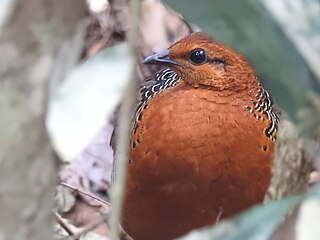
The kipunji, also known as the highland mangabey, is a species of Old World monkey that lives in the highland forests of Tanzania. The kipunji has a unique call, described as a 'honk-bark', which distinguishes it from its relatives, the grey-cheeked mangabey and the black crested mangabey, whose calls are described as 'whoop-gobbles'.

The rail-babbler or Malaysian rail-babbler is a strange, rail-like, brown and pied ground-living bird. It is the only species in the genus Eupetes and family Eupetidae. It lives on the floor of primary forests in the Malay Peninsula and Sumatra, as well as Borneo. It is distantly related to African crow-like birds. Its population has greatly decreased because much of the lowland primary forest has been cut, and secondary forests usually have too dense a bottom vegetation or do not offer enough shade to be favourable for the species. However, it is locally still common in logged forest or on hill-forest on slopes, and probably not in immediate danger of extinction. The species is poorly known and rarely seen, in no small part due to its shyness.

The Sunda clouded leopard is a medium-sized wild cat native to Borneo and Sumatra. It is listed as Vulnerable on the IUCN Red List since 2015, as the total effective population probably consists of fewer than 10,000 mature individuals, with a decreasing population trend. On both Sunda Islands, it is threatened by deforestation. It was classified as a separate species, distinct from the clouded leopard in mainland Southeast Asia based on a study in 2006. Its fur is darker with a smaller cloud pattern.
Dormer's bat or Dormer's pipistrelle is a species of vesper bat. It is the only species in its genus. It is found in Bangladesh, Bhutan, India, and Pakistan. Its natural habitats are subtropical and tropical dry forests, arable land, plantations, rural gardens, and urban areas.
The Ethiopian long-eared bat or Ethiopian big-eared bat is a species of long-eared bat in the family Vespertilionidae.

The ferruginous partridge is a species of bird in the family Phasianidae. It belongs to the monotypical genus Caloperdix. It is found in Indonesia, Malaysia, Myanmar, and Thailand.
Gastrophrynoides borneensis is a species of frog in the family Microhylidae. It is endemic to Borneo and is known from Sarawak and Sabah in Malaysia, but it is likely to be also found in adjacent Kalimantan (Indonesia). Common name Borneo narrowmouth toad has been coined for it.
Microhyla borneensis, also known as the Matang narrow-mouthed frog, is a species of microhylid frog found in the Matang Range in Sarawak, Borneo. It was once the smallest known frog from the Old World. Adult males of this species have a snout-vent length (SVL) of 10.6–12.8 mm (0.42–0.50 in), but adult males can reach a maximum of 13 mm (0.51 in),and adult females of this species have a snout-vent length of 16–19 mm (0.63–0.75 in), Tadpoles measure just 3 mm.

The scaly-breasted bulbul is a species of songbird in the bulbul family. It is found from the Malay Peninsula to Borneo. Its natural habitat is subtropical or tropical moist lowland forests. It is threatened by habitat loss.

The Tongan ground dove, also known as the shy ground dove or friendly ground dove, is a species of bird in the family Columbidae. It is found in American Samoa, Fiji, Samoa, Tonga and Wallis and Futuna Islands. Its natural habitat is subtropical or tropical moist lowland forests. It is threatened by habitat loss.

The Bornean whistling thrush is a species of bird in the family Muscicapidae. It is found in Indonesia and Malaysia, where it is endemic to the island of Borneo. Its natural habitat is subtropical or tropical moist montane forests.

The grey-throated babbler is a species of passerine bird in the Old World babbler family Timaliidae.

The Malaysian giant turtle or Bornean river turtle is a species of turtle in the family Bataguridae. It is monotypic within the genus Orlitia. It is found in Indonesia and Malaysia.

The Bornean horseshoe bat is a species of bat in the family Rhinolophidae. It is found in Brunei, Cambodia, Indonesia, Laos, Malaysia, and Vietnam.
Zollingeria borneensis is a species of plant in the family Sapindaceae. It is endemic to Borneo, and is threatened by habitat loss.

Agathis borneensis, also known as Borneo kauri, is a species of conifer in the family Araucariaceae.
Musa borneensis is a species of wild banana, native to the island of Borneo, in the Malaysian states of Sabah and Sarawak. It is placed in section Callimusa, having a diploid chromosome number of 2n = 20.
Isonandra borneensis is a tree in the family Sapotaceae.
Madhuca borneensis is a plant in the family Sapotaceae.
Vatica borneensis is a tree in the family Dipterocarpaceae, native to Borneo.












